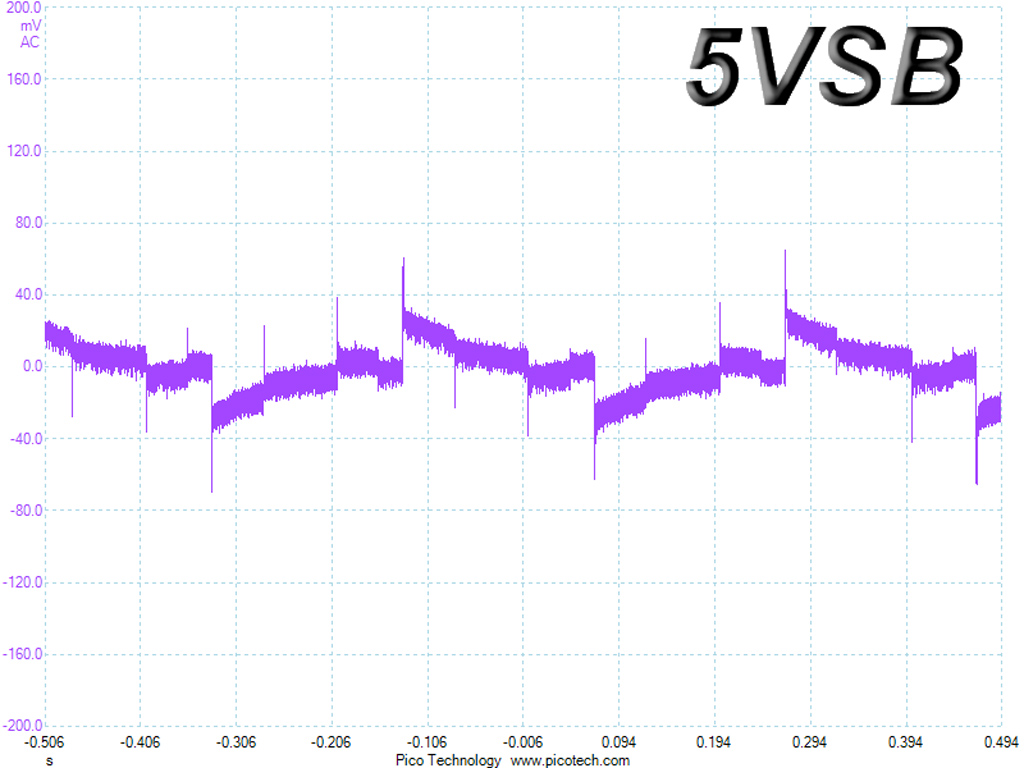Enermax Revolution X’t II 750W Power Supply Review
Enermax recently released a successor to the Revolution X't line and the new models are made by CWT, featuring 80 PLUS Gold efficiency, Japanese caps and a quality fan. Today, we're testing the ERX750AWT model.
Why you can trust Tom's Hardware
Transient Response Tests
Advanced Transient Response Tests
For details on our transient response testing, please click here.
In these tests, we monitor the response of the PSU in two different scenarios. First, a transient load (10A at +12V, 5A at 5V, 5A at 3.3V and 0.5A at 5VSB) is applied for 200ms while the PSU works at 20 percent load. In the second scenario, the PSU is hit by the same transient load while operating at 50 percent load. In both tests, we use our oscilloscope to measure the voltage drops caused by the transient load. The voltages should remain within the ATX specification's regulation limits.
These metrics are crucial because they simulate the transient loads a PSU is likely to handle (such as booting a RAID array or an instant 100 percent load of CPU/GPUs). We call them "Advanced Transient Response Tests," and they are designed to be very tough to master, especially for PSUs with less than 500W capacity.
Advanced Transient Response at 20 Percent
| Voltage | Before | After | Change | Pass/Fail |
|---|---|---|---|---|
| 12V | 12.063V | 11.931V | 1.09% | Pass |
| 5V | 5.064V | 4.972V | 1.82% | Pass |
| 3.3V | 3.369V | 3.235V | 3.98% | Pass |
| 5VSB | 5.046V | 4.978V | 1.35% | Pass |
Advanced Transient Response at 50 Percent
| Voltage | Before | After | Change | Pass/Fail |
|---|---|---|---|---|
| 12V | 12.017V | 11.894V | 1.02% | Pass |
| 5V | 5.033V | 4.939V | 1.87% | Pass |
| 3.3V | 3.331V | 3.194V | 4.11% | Pass |
| 5VSB | 5.011V | 4.944V | 1.34% | Pass |





Transient response performance is satisfactory at +12V and 5V. Although it could be better on the other two rails, the ERX750AWT successfully passes our tests. If anything, we'd like the 3.3V rail to stay above 3.2V during the second measurement.
Here are the oscilloscope screenshots we took during Advanced Transient Response Testing:
Transient Response At 20 Percent Load




Transient Response At 50 Percent Load




Turn-On Transient Tests
In the next set of tests, we measure the PSU's response in simpler transient load scenarios—during its power-on phase.
For the first measurement, we turn off the PSU, dial in the maximum current the 5VSB can output and switch on the PSU. In the second test, we dial the maximum load the +12V can handle and start the PSU while it's in standby mode. In the last test, while the PSU is completely switched off (we cut off the power or switch off the PSU by flipping its on/off switch), we dial the maximum load the +12V rail can handle before switching on the PSU from the loader and restoring power. The ATX specification states that recorded spikes on all rails should not exceed 10 percent of their nominal values (+10 percent for 12V is 13.2V, and 5.5V for 5V).
Get Tom's Hardware's best news and in-depth reviews, straight to your inbox.



A small spike at 5VSB and a more notable one during the last test are our only eyebrow-raising findings, though they're nothing to worry about.
Current page: Transient Response Tests
Prev Page Cross-Load Tests And Infrared Images Next Page Ripple Measurements
Aris Mpitziopoulos is a contributing editor at Tom's Hardware, covering PSUs.
-
powernod The fact that the PSU collapsed during the "Hold-UP time / Power_OK" tests, clearly proves -in my opinion-, how important these tests are, since they are an indication of how properly a PSU can react during stressful situations. ;)Reply -
turkey3_scratch Good unit. Has some things that could be improved, but good. Wish there was much more to say.Reply -
Aris_Mp actually I rarely see a PSU going boom in these tests. Will wait for the second sample to arrive and see how it goes under the same scenario.Reply -
turkey3_scratch Reply17939497 said:actually I rarely see a PSU going boom in these tests. Will wait for the second sample to arrive and see how it goes under the same scenario.
Oh I thought you already got the second sample and it tested fine, guess I misread that. -
GearUp The older line X't have been selling for around $82 so I would have hoped for a lower price as well. Personal experience still favors Enermax since 0/6 of my units failed within 3 months while it was 1/3 for each of 2 different competitors. I still factor in return costs at this point.Reply -
Aris_Mp Just finished testing the second sample and no fireworks this time, so apparently the incident with the first sample (during the hold-up time tests) was just an isolated one.Reply
In addition I confirmed that there is no OCP on the minor rails either, as I suspected. -
android_dev The older Enermax Revolution 87+ series have better build quality ,features and performance than their X't counterparts. Then again it was a more expensive platform to begin with.Reply -
GearUp Correction on returns: Only one supply was returned within 3 months which is good for returns. The other failed due to the motherboard or graphics card after 16 months. Some supplies have return rates well over 20 percent.Reply